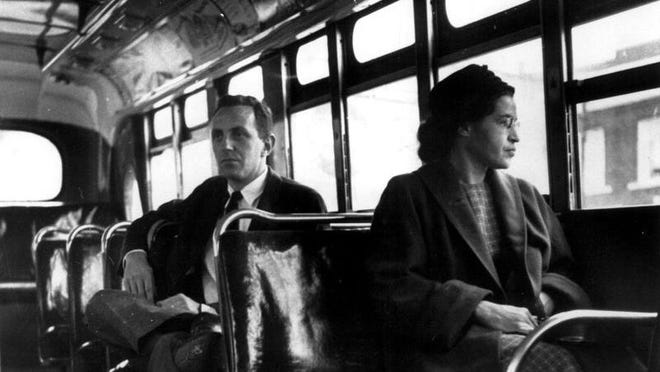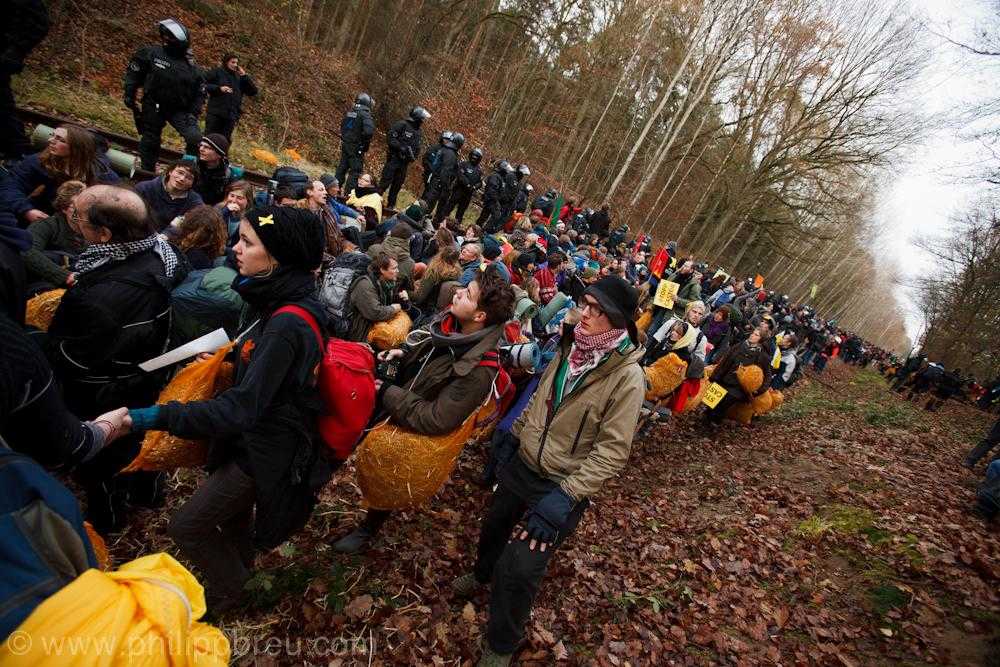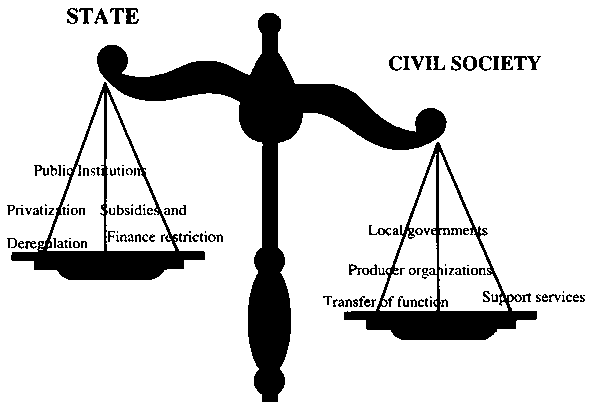How blockades obstruct nonviolence and democratic revolutions
When civil disobedience spread across Europe and the United States, the biggest mistake was perhaps the fixation on blockades. In the rich part of the world, the blockade has been made the dominant method of civil disobedience. In this text, various reasons are analyzed as to why Rosa Parks, Martin Luther King and Mohandas Gandhi did not use blockades.
Gandhi used proactive and performative resistance, and the goal became the means of the struggle, “means and ends are convertible terms”. (Mohandas Gandhi, 1939.) The desired solution to the problem was turned into the method of civil disobedience. When local salt extraction and cotton production were monopolized by the colonial power, Gandhi, together with others, mined salt and spun cotton, breaking the colonial monopoly. This is called performative in queer feminist theory and is similar to Gandhi’s concept of nonviolence, where means and ends are the same. A performative is an action that realizes its vision.

Later, Rosa Parks abolished apartheid in a bus seat reserved for white people until she was arrested and taken to the police station. The method spread, and instead of waiting on others to make changes, civil rights groups directly abolished apartheid in restaurants until they were arrested. Liberation became the means of liberation. Means and ends were the same, as Gandhi would say. Civil disobedience became a way to govern together with others, rather than to protest and influence those who dominate.
Since 1980, plowshare groups have used blacksmith hammers to start beating weapons into something useful. In court, they apply the law as if it is just and protects life from violence. If nevertheless, they are sentenced to prison, plowshare groups tear down the prison walls. The walls are reversed – they face outwards, using fear to make others obedient. However, plowshares groups tear down these walls of fear and make themselves at home instead of reproducing the prison as a tool of obedience.
The genius of Gandhi was largely filtered out when nonviolence was exported to the colonial powers, to the rich north. The dominant method of blockading converts nonviolence into a power game. So, what is making a blockade a political mistake?
- Blockades block the creative construction of society. Creating is replaced by obstructing.
- Instead of turning means and ends into one, the blockade splits them. The visionary goal is postponed into the future, realization is replaced by non-realization, and political vision is replaced by negation, trying to stop something.
- When a blockade is focused on a center of power, it creates a direction that reinstates the power center as the center. If protests turn toward a center, placing it in front, other group’s solutions are placed behind. By thereby turning its back on practical democracy, protest deposes liberation. This consolidates existing power centers. Nonviolence in the tradition of Gandhi enables us to turn toward each other, appointing each other as citizen-rulers, and assigning each other power.
- The blockade recreates a masculine measurement of strength, instead of innovative organizing of egalitarian and creative societies that intervene and displace other power structures. Vulnerable community building is replaced by an arena for power struggles.
- Instead of inventing, constructing, and experimenting with liberation, the blockade reproduces power games. Inviting and welcoming are displaced by scoring political points in the media.
- Blockades replace the uncertainty of democracy and the vulnerability of nonviolence with military notions of politics: win and lose, strength and dominance, tactics and strategy.
Reproducing the worldview of war
In the days of Gandhi, parts of the Left had already been caught up in warlike metaphors of strength and power, tactics and strategy. This was partly expressed in the act of counting participants, the total number of strikers or protesters. Faith in a force originating from numbers is a form of “number magic”. Power is drawn and extracted from the number of protesters. This number magic led to a fixation on mass movements, mass action, mass media, mass opinion, and the number of signatures on petitions. Measurement of strength was perceived as the path to social change.
When nonviolence got translated to the powerful north, the same mistakes were made as in these examples of the Left. Civil disobedience within the colonial powers was fixated on methods that would compete with the strength of the “rulers”.
The blockade becomes the obvious analogy to the strike. A blockade, like a strike, is expected to hinder the activities of the opposing party. Liberation and the revolution of nonviolence are replaced by negating power: hindering, stopping, blocking. The blockade attempts to solve a problem by being its negation: not wanting what they want. It is intended to hinder and possibly stop an operation. Blockades replace political and democratic transformation with obstruction.
The current order is made into the playing field. The blockade then reproduces this field instead of transcending it. The conclusion is that the notions behind blockades come from a metaphorical and superstitious link between politics and strength, and between political power and masculinity.
Extracting energy from measurement

Just as in mass demonstrations, the number of blockaders becomes a metaphor, where the number of participants is assumed to measure the strength of public opinion. The constructive dynamics of dialogues, arguments and conflicts are replaced by counting opinions. This displaces the democratic conversation that might transform our thinking. Instead of letting reflections and arguments change our understanding and build new societies, the protest attempts to win over the opposing side. Innovative conversations are replaced by information and persuasion. The journey into the unknown is blocked. A blockade then makes politics static and conservative. As with political debating techniques, it pushes democracy into defensiveness.
A mass demonstration extracts energy from its numbers. Capitalism is built on measuring value, and this approach also colonizes politics and activism. However this belief in the power of numbers becomes a form of superstition within radical politics.
Fixation on the size of an action becomes fetishism, activism extracting energy from numbers. The feeling of being powerful could also come from physical strength, for example, linking arms, using clever obstacles such as ropes or boulders, or gluing hands together inside steel pipes. Extracting energy from power games is different from vulnerable disobedience in realizing the society we want. As Martin Luther King wrote, “we must see that the end represents the means in process and the ideal in the making (…) the end is pre-existent in the means.” (Martin Luther King, 1961.)
Unconsciously, the blockade might exploit guards and police to produce embodied experiences of power; the blockade then extracts energy from using physical strength in these encounters. Turning this showdown into a stimulus and source of energy is a form of fetishism.
In a paradoxical way, magical fetishism extracts power both from masculine strength measurements, as analyzed above, and also from turning arrested blockade activists into victims of the police. This contradiction between strength and martyrdom allows fetishism to extract double energy from blockades.
Unintentional violence
Without intention, blockades in some situations become violent. Blocking vehicles can be so effective that ambulances, medical transports, or organ transplants get delayed. These concerns relate to blockades of transport systems, roads and gates, as well as blockades of helicopters and aircraft. Blockaders attempt to counteract this, but despite allowing ambulances to pass, there still might be a delay. What is even more difficult to solve is if the roadblock also delays private cars and taxis driving someone to the emergency department.
Tolerance for violence: Tumults and drama during a blockade sometimes tempt participants to tolerate violence from their fellow activists toward the police, especially if the police have been violent. In this case, one’s own violence is camouflaged by pointing to the violence of oppression.
Blockades strengthen the prevailing order of power

During the bourgeois revolutions, the nation-state emerges by producing opposites: state vs civil society, public vs private, state vs individual, and government vs opposition. These opposite pairs get stuck in a dialectical game where they give each other power, a bit like partner dancers giving each other energy or the plus and minus poles of a battery.
Hegel argued that the nation-state could not develop without opposition. The nation-state draws power from its counterparts. Without a counterpart, power stagnates. Modern states need protest and opposition in their engines to produce power. Counterparts or opposing powers strengthen and develop each other. This is, according to Hegel, a dialectic dynamic. We can understand dialectic with the help of partner dancing and contra dancing. Contra dancers give each other energy by both following and countering each other. Contra dance and partner dance might help us to understand modern politics.
The theory behind this will be explored in more detail in the rest of the article.
Civil disobedience is governing
Nonviolence in the tradition of Gandhi breaks out of the dialectical contradiction by turning means and ends into one. In this way, nonviolence is governing. Civil disobedience, then, does not direct itself against a center of power. Nonviolence avoids the dynamic of partner-dancing with the opponent. Nonviolence is to perform and realize, to govern rather than appointing another actor.
When civil disobedience is governing, solving problems and changing the order, the police and the judiciary become the protesters. “No, you can’t do that!” They point out the civil disobedience and the defendants as the actors. The government (prosecutor), and later the law (judge), define and point to the accused as the accountable actors. When the law turns against civil disobedience, it actually directs itself towards nonviolence. It puts nonviolence at its center. It then appoints the affinity group doing civil disobedience as the responsible actor.
Gandhi turned the roles upside down: who is acting and who is protesting, who is creative and who is trying to stop the accomplishment. The blockade turns instead against the state, thus directing itself to another center than liberation. When trying to stop something, the blockade appoints the other party as the doer, the one who realizes and implements. The blockade then defines and expresses itself as the one that does not accomplish and realize the society they want.
How blockades strengthen the opponent’s power
- Blockades point to the opponent as the protagonist of the drama. The blockade impedes the activities of the counterparty. A government or a company is made into the actor. Their business is defined as the productive activity that needs to be hindered. The counterparty is thus made into a center.
- Blockades are reactive rather than proactive. By reacting, they confirm what they are reacting to. In Gandhi’s more famous civil disobedience, it was instead the police who became reactive and tried to prevent liberation. Alternatively, the police become passive, as during the first salt march, when they allowed the salt extraction. In this ingenious way, Gandhi elegantly reverses the expected roles. Who is the actor? Who is the subject of democracy? Who governs? Who performs political transformation? With their “No-you-can’t-do-that!” police officers and prosecutors become protesters, they point to the liberation as the subject. Nonviolence reigns instead of protesting and reacting. Nonviolence here becomes an actor instead of an obstacle. In this way, civil disobedience might tempt police and prosecutors to become the protest movement, those who want to stop and say no! However, the blockade makes the same mistake as the colonial police who tried to obstruct Gandhi and the independence movement, it reduces itself to an obstacle, a negation.
- The blockade recreates this modern version of power politics trying to win against one’s opponent. Democracy is transformed into a competition. The power game of blockades enforces prestige, where one side must win and the other loses.
- Blockades invite a loss into the struggle. To counteract the built-in frustration, blockaders create temporary partial victories. The partial victory is measured in how long the loss can be postponed. “Oh amazing, we blocked the company for three days!” “Whoa, there were a thousand of us blocking! Much more than last time!”
- Blockades become a measurement of strength that recreates the neoliberal ideal: value should be measured. Blockades therefore performatively realize the neoliberal society of measurement.
- The blockade becomes part of an order of power that strengthens the one who is already strong. Just like in wrestling or tug-of-war, a competition might be created where tactical techniques and strength are transformed into the logical ideal. The measurement of political strength becomes a goal in itself. Blockades become a performative action realizing power politics. This realized goal might contradict what the blockaders want to achieve.
- In the extension of the measurement of strength, violence lures as a possibility. This temptation is seen in wrestling where violence is an expected violation in a competition of strength and where judges are needed to adjudicate. This temptation created by physical strength is another reason to avoid blockades.
The blockade game produces rules, contexts and goals that might contradict what the blockaders actually wish to achieve. The built-in dynamics of the blockade counteracts real change. It blocks the very purpose of nonviolence: the direct creation of egalitarian democratic societies, in which orders other than obedience, strength and violence rule.
In contrast to protests and blockades, civil disobedience in the tradition of Gandhi becomes the desired transformation. When the justice system is trying to prevent this actual and realized change, it reduces itself to a negation. The police and prosecutors become the protesters.
Per Herngren
April 14, 2023, version 0.1.4
This article was published in The Nuclear Resister July 13, 2024.
Referens
Judith Butler, Excitable Speech: A Politics of the Performative, New York: Routledge, 1997.
Judith Butler, Notes Toward a Performative Theory of Assembly, Harvard University Press, 2015.
Martin Luther King Jr., ”Love, Law, and Civil Disobedience”, Speech that Dr. King delivered in 1961 to the annual meeting of the Fellowship of the Concerned in Atlanta. King, Martin Luther King, Jr., A testament of hope : the essential writings of Martin Luther King, Jr. San Francisco: Harper San Francisco: 1991.Mohandas Gandhi, Gandhis Collected Works vol 76, ebook, 1999.
Per Herngren, Path of Resistance, Philadelphia: Movement for New Society, 1993.
